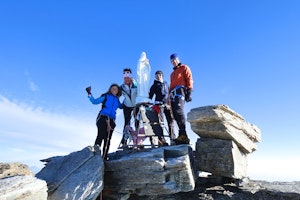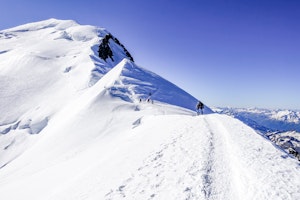Whether you are heading out for a single day or an entire month, it is important to take certain precautions in order to safely enjoy a successful trip.
While the vast majority of hikers, mountain climbers, and backcountry skiers do not encounter problems when they head out into nature, conditions can change rapidly. Being prepared can be the difference between a successful expedition and a failure to launch.
Due to climatic conditions and the inherent nature of mountain terrain, it is impossible to eliminate all the risks involved in heading out into the mountains. However, there are many ways to greatly reduce that risk. We’ve shared some of the most important ones with you below.
1. Plan your route
The first step that you can take to help ensure a successful trip into the mountains is to plan your route.
This means making sure that you know how to get to the trailhead and being able to identify the paths you want to follow on a topographical map (cell phones won’t always have service in the backcountry).

Always carry a topographical map of the area in which you are heading. Cell phones do not always work in the backcountry, Photo courtesy of Fabrice Henon.
When planning your route, keep in mind the physical fitness level of yourself and the rest of the group. It is also a good idea to plan a backup route in case the weather changes for the worse at higher altitudes or you find yourself with less energy than you had previously imagined.
If you plan on making an overnight trip, be sure you know where you will be camping overnight. If you plan on staying in a mountain hut, be sure to make a reservation ahead of time, especially if your trip is planned during the high season.
Finally, before you head out on your adventure, inform someone of where you are going and what your plan is. Telling friends or family and local officials, such as national park rangers or ski patrol officers, will help them to track you down in case something goes wrong.
2. Pack properly
There are several key components required in a successful adventure that takes you off the beaten path and into the heart of the mountains. One of the most critical components is packing appropriately.
Be sure you have brought all the necessary equipment for whatever it is you plan on doing. Bringing the correct equipment can be the difference between a successful trip and returning home early.

A rule of thumb in trekking: weight is the enemy. Be sure to pack according to the exact nature of the trip. Photo courtesy of James Kniffen.
If you are planning on heading out with a mountain guide, ask him or her what equipment is necessary and whether he or she will provide it. If not, make sure you can rent it at the start of the trip or beforehand.
If you are heading out into the backcountry without a guide (which is not recommended unless you have the proper training) then consult the trusted sources on the internet to determine what you need to bring.
Regardless of where you are going and what you are doing, there is one essential item of which everyone must bring plenty: water. Staying hydrated is imperative in the backcountry, so be sure to bring enough water for your trip or water purification tablets if you will be out in the backcountry for longer stretches of time.
3. Pick the right challenge
While everyone may dream of summiting Everest or some other massive snow-capped peak, it is important to be realistic about what you can and cannot accomplish and plan accordingly.
For example, if you are a strong hiker, but do not have previous rock climbing or mountaineering experience, then it is best to just stick with walking. The same is especially true with skiing. If you have not gone off-piste before, don’t try it out alone.

Know your physical and technical limits before you plan your next adventure to the mountains. Photo courtesy of Miyar Adventures.
If you have some experience mountain climbing or heading off-piste, it is important to know your limits. Don’t try something you haven’t done before unless you are on a course specifically designed to improve your skills.
For those eager to learn a new sport or improve their skills at an existing one, there are plenty of options for doing so. Certified guides all over the world offer hands-on courses that will provide you with the necessary experience and preparation to take your skills to the next level (or the first one).
Along with the technical aspect of heading into the mountains, it is also important to pick the right physical challenge. Don’t overestimate yourself. It is best to underestimate and slightly increase the challenge than the other way around.
4. Check the forecast and come prepared for changing weather
Before heading out into the mountains, it is important to know what you might be getting yourself into. Always be sure to check weather forecasts and snow conditions ahead of time and plan or change your itinerary accordingly.
When you are up in the mountains, the weather can change quickly and dramatically. Even a day on which clear skies were predicted can instantly turn into a mid-afternoon thunderstorm or snowstorm.

Up in the mountains, the weather can change quickly. Check the upcoming forecast before you head out, but be prepared for something different all the same.
Being prepared for these quick and unpredictable changes in the weather is usually the difference between a successful experience and failed – even potentially dangerous – trip.
This means bringing clothes for when it is hot, cold, wet and windy. Keeping dry is essential, especially if you will be in the mountains for multiple days. Wet clothes make you colder and can put you at risk of hypothermia. For these reasons, guides recommend packing clothing made from synthetic materials and always bringing rainwear.
When there is a storm on the mountain, it is generally best to sit tight and wait for the weather event out. However, if you must keep moving, then take a lower route. Exposed ridges are incredibly dangerous during storms.
This is where route planning plays an important role. Before heading out up the mountains, be sure you have a backup plan for inclement weather.
If you’re going to encounter snow on your trip, you should also be well aware of avalanche safety. This includes prevention (many avalanches are caused by humans!)-which is always a lot safer than rescue- and also rescue skills in case you do encounter a worst-case scenario.
5. Hire a certified mountain guide
There are plenty of reasons why it is important to hire a certified mountain guide before heading out into the mountains.
Not only is their job to keep you safe while providing an unforgettable experience, but these people are usually local and highly knowledgeable.

Traveling with a local and certified mountain guide will increase the safety and enjoyment of your trip. Photo courtesy of Ilia Berulava guiding Team.
Your guide will be able to take you along the best routes, avoid overpopulated areas and show you that view that just isn’t in the guide books.
Traveling with a certified mountain guide is a bit like taking out the ultimate insurance policy. These guides will check the weather forecasts and snow conditions with you.
Many of them work within a network of other guides, which keeps them updated about conditions in the mountains and will allow you to plan your route accordingly.
Finally, mountain guides make good company. They have a lot of interesting experiences and will be able to tell you a bit about the local area as you go. Your guide makes the perfect travel companion for so many reasons.

Heading on an adventure to the mountains can be a magical experience. Increase your odds of a successful trip by following the safety advice above. Photo courtesy of Peaks Hunter Mountain Guide Team.
Heading out into the mountains almost always makes for an unforgettable experience. In order to get the most out of your trip – and ensure there is a next one – follow these mountain safety tips. You can never be over-prepared for heading into the backcountry.








